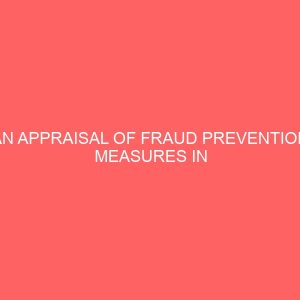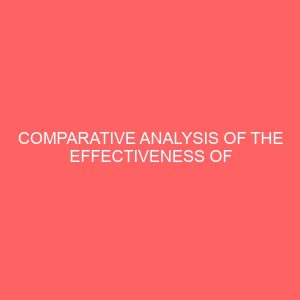Description
This research writing is on The impact of credit management on the profitability of a manufacturing firm
ABSTRACT
The aim of this research work is to appraise “The impact of credit management on the profitability of a manufacturing firm focused on Unilever Nigeria Plc Aba”. This is because; trade credit is a short term source of finance and sometimes take the form of bills payable. The statement problem of this research banks about the poor level of credit management and also the problems which the firms encounter as a result of high-rate of bad debts. The objective of this research study is to highlight the effects of the credit management on the profitability of the company as well as to highlight the advantages of effective and efficient management of trade credit amongst others. Furthermore, this research work will be of immense significance to the staff of Unilever Nig. Plc Aba as well as the students and the researcher since it aims at providing effective means of reducing default in collection of accounts. Also, research questions like; could a company’s liquidity problem be attributed to bad debt? On the average, how long do you allow credit to customers? Etc. research instrument used were questionnaires for the purpose of obtaining the desired result. In treating and analyzing the data collected, an extensive use of tabular information and percentages were of great importance. In the light of the findings and conclusions of this work, the following recommendations are put up: that then should be a regular review of credit policies to suit the changes in the business environment and that an enquiry unit should be established to take responsibility for prospective credit’s assessments amongst others.
TABLE OF CONTENTS
Title page = = = = = = = = = i
Approval Page = = = = = = = = ii
Dedication = = = = = = = = = iii
Acknowledgement = = = = = = = iv
Abstract = = = = = = = = = v
Table of contents = = = = = = = = vi
CHAPTER ONE
1.0 Introduction = = = = = = = 1
1.1 Background of the Study = = = = = = 1
1.2 Statement of the Problem = = = = = 3
1.3 Objective of the Study = = = = = = 5
1.4 Formulation of Research Hypotheses = = = 6
1.5 Research Questions = = = = = = 7
1.6 Significance of the Study = = = = = = 8
1.7 Scope of the Study = = = = = = = 9
1.8 Limitations of the Study = = = = = = 9
1.9 Definition of Terms = = = = = = 10
CHAPTER TWO
2.0 Literature Review = = = = = = 12
2.1 Reasons for granting credit = = = = = 14
2.2 Setting credit policy and Regulation = = = = 17
2.2.1 Credit Standards = = = = = = = 18
2.2.2 Credit Terms = = = = = = = 18
2.2.3 Collection Efforts = = = = = = = 19
2.3 Credit Policy Goals = = = = = = 20
2.3.1 Optimal Credit Policy = = = = = = 20
2.4 Credit Policy Variable Analysis = = = = 22
2.4.1 Credit Analysis = = = = = = = 23
2.4.2 Credit Scoring = = = = = = = 24
2.4.3 Collection Policy and Procedures = = = = 26
2.4.4 Establishing Internal Collection Procedure = = = 26
2.4.5 Other Collection Procedures = = = = = 27
2.4.6 Monitoring Receivables = = = = = = 28
References = = = = = = = = 34
CHAPTER THREE
3.0 Research Methodology = = = = = = 35
3.1 Research Design = = = = = = = 35
3.2 Area of Study = = = = = = = 36
3.3 Sources of Data = = = = = = = 36
3.4 Population of the Study = = = = = = 37
3.5 Instrument of Data Collection = = = = = 38
3.6 Validation of the Instrument = = = = = 38
3.7 Reliability of the Instrument = = = = = 39
3.8 Method of Data Analysis = = = = = = 39
3.9 Sample Design and Determination of Sample Size = = 40
CHAPTER FOUR
4.0 Presentation, Analysis and Interpretation of Data = = 42
4.1 Analysis and Interpretation of Data = = = = 42
4.2 Test of Hypotheses = = = = = = 55
4.3 Test of Hypothesis 1 = = = = = = 56
CHAPTER FIVE
5.0 Summary of Findings, Conclusion and Recommendations 68
5.1 Summary of Findings = = = = = = 68
5.2 Conclusion = = = = = = = = 69
5.3 Recommendations = = = = = = 71
Bibliography = = = = = = = 73
Appendix 1 = = = = = = = = 75
Appendix II = = = = = = = = 76
CHAPTER ONE 1.0 INTRODUCTION
1.1 BACKGROUND OF THE STUDY
Credit management is a term used to identify accounting functions usually conducted under the umbrella of accounts receivables. Essentially, this collection of processes involves qualifying the extension of credit to a customer, monitors the reception and logging of payments on outstanding invoices, the initiation of collection procedures, and the resolution of disputes or queries regarding charges on a customer invoice. When functioning efficiently, credit management serves as an excellent way for business to remain financially stable.
Competent credit management seeks to not only protect the vendor from possible losses, but also protect the customer from creating more debt obligations that cannot be settled in a timely manner.








Reviews
There are no reviews yet.